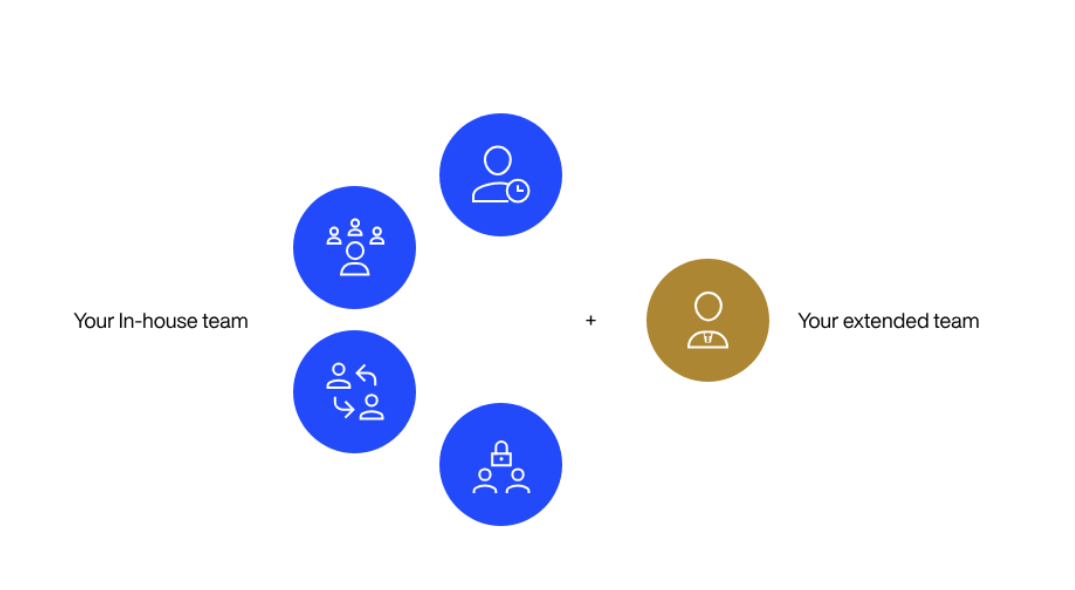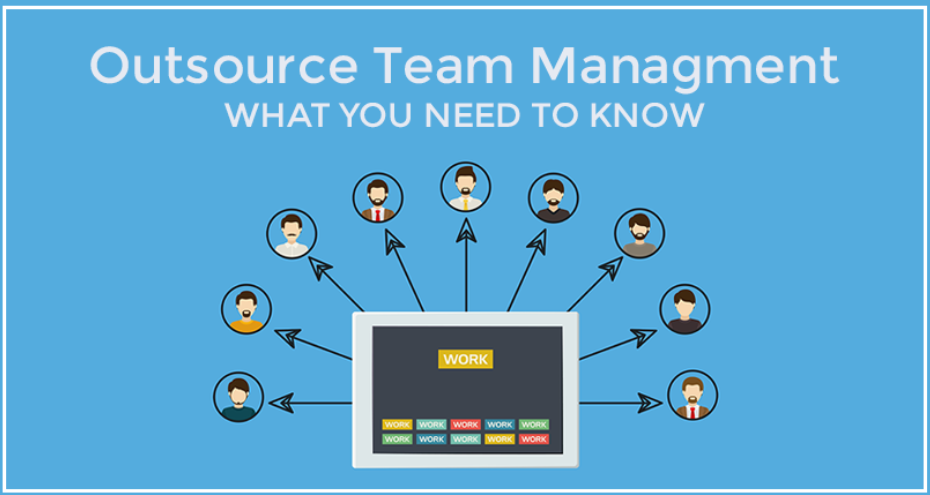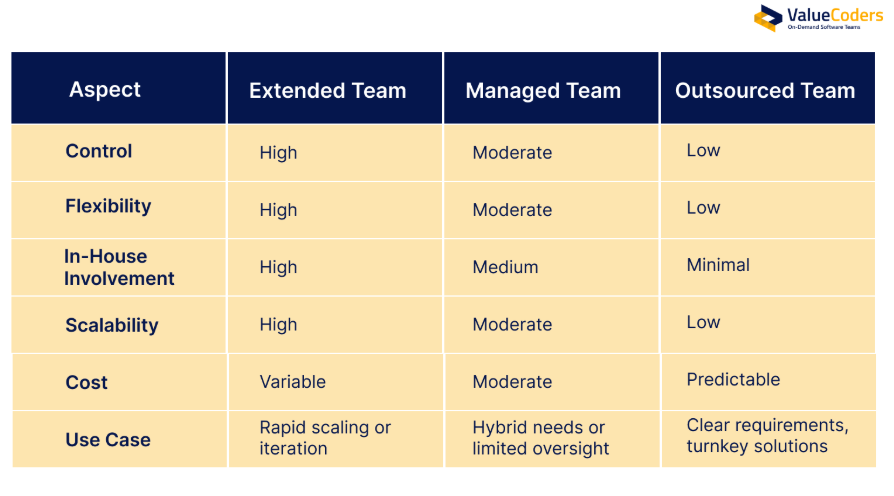Modern companies often switch to software outsourcing to augment their capabilities to stay competitive and meet evolving demands in today’s competitive era. However, outsourcing cannot be chosen every time.
Depending on the project’s scope, size, complexity, and timeline, they can choose from three primary options: extended teams, managed teams, or outsourced teams. Each model offers unique benefits and limitations, making it crucial to understand the differences.
Let’s read this blog post to learn the key difference between “managed services vs outsourcing team vs extended team.” You will explore their features, use cases, and factors when choosing the right model for your business.
About Extended Teams

An extended team integrates external developers into your in-house team while allowing you to retain complete control over the project. It’s not about outsourcing software development but hiring specialized talent to complement your workforce.
Its key features include:
- In-house Control: The internal project manager oversees all processes, ensuring the extended team is an integral part of the company.
- Scalability: This model allows businesses to scale their workforce quickly by hiring Hire dedicated software development teams and individual experts as required.
- Remote Integration: Team members typically work remotely but are embedded into your processes, communication channels, and workflows.
- Flexibility: You can adjust the size and skill set of the extended team as the project evolves.
Use Cases
An extended team suits companies that need extra hands but want to maintain their working style and culture. This model shines when capable project managers can manage additional team members.
Extended teams work particularly well for:
- Startups: Ideal for startups developing a product with evolving requirements. An extended team provides the flexibility to make rapid changes without long-term commitments.
- Companies Scaling Rapidly: Businesses experiencing growth may need additional hands to keep up with demand but lack the time or resources to onboard new employees.
- Specialized Skills: An extended team can fill the gap if your project requires expertise in specific technologies or niches.
Advantages of Extended Teams
Extended teams allow businesses to expand their capabilities without the commitment of hiring full-time staff. This model integrates external talent seamlessly into your existing workflows, providing the following benefits:
- Direct control over development
- Quick team scaling
- Seamless integration with existing processes
- Real-time communication
- High flexibility for changes
Challenges
While extended teams offer flexibility, they require significant oversight and coordination from in-house management. Let’s look at the following key disadvantages:
- Needs strong project management
- Requires more internal resources
- Higher communication overhead
- More management responsibility
- Cultural alignment challenges
About Managed Services Teams

A managed team operates as an independent unit within your larger project framework. The outsourcing partner provides a dedicated team, including a project manager, who collaborates with your in-house stakeholders.
While you maintain oversight, the external team is responsible for delivering results. Its key features include:
- Autonomy with Accountability: The external team works independently but reports back to your in-house team regularly.
- Clear Communication Protocols: Rules of engagement, decision-making responsibilities, and reporting structures are established upfront.
- Comprehensive Roles: Teams often include roles such as Software Architects, Scrum Masters, and QA engineers to ensure a smooth development process.
- Risk Sharing: The outsourcing partner shares responsibility for the project’s success.
Use Cases
This model works well when you want to be involved in key decisions without managing daily operations. It provides structure while maintaining your input on crucial aspects.
Managed teams excel in these scenarios:
- Complex Projects: Managed teams are ideal for projects requiring a combination of autonomy and in-house input.
- Limited Management Bandwidth: A managed team can take on a significant portion of the workload if your internal project managers are stretched thin.
- Hybrid Needs: Businesses that need flexibility but want to retain some control often find managed teams to be a perfect fit.
Advantages of Managed Teams
Managed teams balance autonomy and collaboration, making them ideal for projects requiring external expertise with a layer of in-house supervision. Some other key advantages are given below:
- Balanced control and autonomy
- Professional project management
- Ready-to-work teams
- Technical expertise included
- Reduced management burden
Challenges
Managed teams depend on clear communication and predefined processes. Misaligned expectations or lack of transparency can lead to inefficiencies and delays. Let’s look at the following disadvantages:
- Potential communication gaps
- Less direct control
- Higher costs than extended teams
- Dependency on the provider’s processes
- Possible cultural differences
About Outsourced Teams

Software outsourcing Services take full responsibility for the development process. You provide the requirements, and the outsourcing partner delivers the finished product within the agreed timeline.
This model is the most hands-off, requiring minimal involvement from your in-house team. Its key features include:
- Turnkey Solution: The external team handles everything from planning and development to testing and deployment.
- Defined Scope and Timeline: Projects are executed based on predetermined specifications and deadlines.
- Reduced Internal Involvement: In-house project managers only need to provide initial input and occasional updates.
Use Cases
This approach suits businesses wanting to focus on core operations while leaving technical execution to experts.
Outsourced teams fit best in these cases:
- Overburdened Teams: If your internal teams are at capacity, an outsourced team can take on standalone projects.
- Clear Requirements: Best suited for projects with well-defined goals, scope, and deliverables.
- Cost-Effectiveness: Businesses looking to save on operational costs often opt for outsourcing.
Advantages of Outsourced Teams
Outsourced teams handle entire projects independently, delivering completed solutions on time and within budget. This hands-off approach is ideal for businesses with limited internal capacity or clear project specifications.
Have a look at its key benefits below:
- Minimal internal involvement
- Predictable costs
- Complete project handling
- Access to varied expertise
- Fixed deliverables
Challenges
Outsourced teams offer less flexibility for adjustments and rely heavily on the partner’s ability to understand and execute project requirements. Some of its other disadvantages are:
- Limited flexibility for changes
- Less control over processes
- Communication barriers
- Longer customer feedback loops
- Potential quality concerns
Key Factors to Consider When Choosing a Model
Selecting the right outsourcing model whether it is nearshore software outsourcing or offshore software outsourcing model, depends on your business’s unique needs.
Here are the key factors to consider when outsourcing projects to a software development company:
1. Flexibility
Let’s give a thought to this question before making the final choice between “managed services vs outsourcing team vs extended team.”
How much room do you need to adapt the project’s scope, requirements, or timelines?
Extended teams provide the highest flexibility, while outsourced teams are best for fixed-scope projects. You must define the following business goals:
- Speed to market requirements
- Quality expectations
- Cost management needs
- Long-term scaling plans
2. In-House Resources
You must encounter the following question before making a final choice between “managed services vs outsourcing team vs extended team.”
Do you have experienced project managers and technical leads to oversee the process?
An extended team requires significant internal resources, while managed or outsourced teams reduce this burden. You must follow these approaches:
- Consider your project management capacity
- Evaluate technical oversight abilities
- Account for communication bandwidth
- Check internal expertise availability
3. Project Scope
You must have the following questions in your mind while making selection between “managed services vs outsourcing team vs extended team.”
How complex is your project?
Does it require ongoing changes or is it straightforward?
Managed teams are suited for mid-level complexity, while outsourced teams work well for clear and well-defined projects.
The project control need are given as:
- Extended Team: High direct control
- Managed Team: Shared control
- Outsourced Team: Minimal direct control
4. Budget and Timeline
Have you ever considered the following questions:
What is your budget?
Are you looking for the fastest solution, or do you prioritize control and quality?
Outsourced teams are often cost-effective but may have less flexibility for adjustments. The project characteristics are listed below:
- Timeline requirements
- Budget constraints
- Scope flexibility needs
- Technical complexity
A Comprehensive Comparison of “Managed Services vs Outsourcing Team vs Extended Team”
Understanding the key differences between these three models is essential for choosing the right approach for your business. Each option offers unique benefits tailored to different project needs, team capacities, and timelines.

Conclusion
Choosing the right outsourcing model significantly affects the success of your software development projects.
Extended teams work best for businesses seeking flexibility and close collaboration. Managed teams are ideal for those who must balance autonomy and in-house input. Outsourced teams, on the other hand, are suited for projects requiring minimal oversight.
Success with any model depends on matching your needs with the right approach. While outsourcing software development, you must consider your internal capabilities, project requirements, and long-term goals.
Remember that these models can evolve as your business grows and needs change.
The right choice brings faster development, better quality, and successful project completion. Evaluate your situation and choose the model that aligns with your company’s capabilities and objectives.
